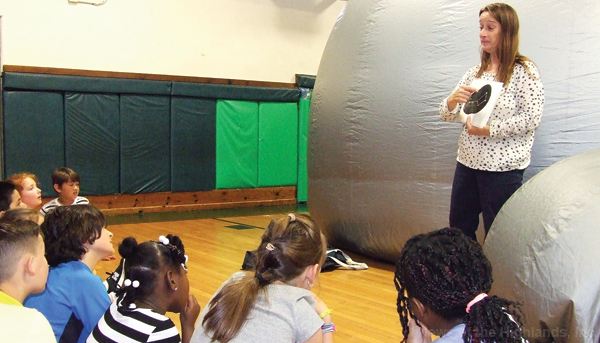
Before the school year ended, students in Cornwall-on-Hudson Elementary school received a special visit. Lisa DiMarzo, founder of Impact Education, brought her portable planetarium and treated the kids to a sky show, in the gymnasium.
The Star Lab is a 20-foot wide inflated planetarium with a dome that allows those inside to see the stars and constellations. Using a projector, DiMarzo is able to show the exact position of the stars on any given day. She can put the stars in motion to show their nightly progression from east to west.
In actuality, DiMarzo explains to the students, the stars don’t move, but they appear to do so because of the Earth’s rotation on its axis.
Before entering the Star Lab, DiMarzo asks the students what a constellation is – a picture made from stars. Each constellation has a story associated with it. Then she asks what constellations they know. Some of the answers included the big and little dipper, Orion, and Leo the Lion.
The big dipper, DiMarzo explains, is part of the Great Bear, also called Ursa Major. The little dipper is part of the little bear, also known as Ursa Minor. The big dipper is useful to those who get lost in the night because it aids in locating the north star, which is always facing north. To use the dipper this way, DiMarzo said, connect the cup and trace the front end to the last star in the handle of the little dipper. This is Polaris, one of the brightest in the sky.
DiMarzo also explains that a star’s color indicates how hot it is. Blue stars are considered hot stars while red ones are cool stars. By comparison, the Sun is a white star, which in terms of temperature is somewhere in the middle. Although the Sun looks big in the sky, it’s not even the biggest star. It only looks that way due to its proximity to the Earth.
Inside the inflatable dome, DiMarzo pointed out a “w-shaped” group of stars known as Queen Cassiopeia. She’s located in a band of millions of stars called the Milky Way.
DiMarzo changed the slide in her projector in order to show all the constellations such as Leo, Scorpio, Orion, and Draco the Dragon. She told a four-minute story about three hunters chasing a bear. Watching the Great Bear over the course of four seasons, it looks like it emerges from its cave in the spring, while hunters chase it before the bear returns home to hibernate during the winter.
